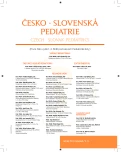Intrafamiliar phenotype variability of classic Marfan syndrome
Authors:
S. Machalová 1; E. Čmelová 1; D. Ďurovčíková 1; M. Pechová 1; M. Hikkelová 2
Authors‘ workplace:
Klinika lekárskej genetiky SZU a UNB, Bratislava
prednostka doc. MUDr. D. Ďurovčíková, CSc.
1; MedGen, s. r. o., Bratislava
vedúci MUDr. RNDr. A. Genčík, CSc.
2
Published in:
Čes-slov Pediat 2015; 70 (5): 287-292.
Category:
Case Report
Overview
Marfan syndrome is a rare systemic disorder of the connective tissue affecting skeletal, cardiovascular system and also eyes. The estimated prevalence within different ethnic groups is 1 : 3–5,000.
We provide intra-familiar phenotype variability, new diagnostic criteria and autosomal dominant inheritance information within casuistic of a 16-year old male subject with fully developed signs of Marfan syndrome and within gentle phenotype of his father. We managed to provide evidence of identical, up to now undefined, "splicing" mutation c.7820-1G>A within FBN1 gene in its heterozygous state. The actual usage of genetic diagnostic tests in order to confirm exact diagnosis significantly contributes to improvement of comprehensive health care management provided to subjects with this potentially fatal disorder.
Key words:
Marfan syndrome, phenotype variability, gene FBN1, revised diagnostic criteria
Sources
1. Redlinger Jr. RE, Rushing GD, Moskowitz AD. Minimally invasive repair of pectus excavatum in patients with Marfan syndrome and marfanoid features. J Pediatr Surg 2010; 45 : 193–199.
2. Van Dijk FS, Hamel BC, Hilhorst-Hofstee Y. Compound-heterozygous Marfan syndrome. Eur J Med Genet 2009; 52 : 1–5.
3. Franken R, Wan den Hartog A, Singh M, Plus G. Marfan syndrome: Progress report. Progress in Pediatric Cardiology 2012; 34 : 9–14.
4. Lebreiro A, Martins E, Cruz C, Almeida J. Genotypic characterization of a Portuguese population of Marfan syndrome patients. Revista Portuguesa de Cardiologia (English Edition) 2011; 30 : 649–654.
5. Gen Gao L, Luo F, Hui Ru-Tai. Recent molecular biological progress in Marfan syndrome and Marfan-associated disorders. Ageing Res Rev 2010; 9 : 363–368.
6. Ahimastos A, Aggarual A, Savarirayan R, Dant AM. A role for plasma transforming growth factor - B and matrix metalloproteinases in aortic aneurysm surveillance in Marfan syndrome. Atherosclerosis 2010; 209 : 211–214.
7. Baker J De, Loeys B, Paepe A De. Marfan and Marfan-like syndromes. Artery Res 2009; 3 : 9–16.
8. Loeys BL, Dietz HC, Brauerman AC. The revised ghent nosology for the Marfan syndrome. J Med Genet 2010; 47 : 476–485.
9. Pritchard D, Korf B. Základy lékařské genetiky. 1. vyd. Praha: nakladatelství Galén, 2007 : 1–224. ISBN 978-80-7262-449-2.
10. http://www.marfan.org/marfan/2280/about-marfan-syndrome, 14. 03. 2013.
Labels
Neonatology Paediatrics General practitioner for children and adolescentsArticle was published in
Czech-Slovak Pediatrics

2015 Issue 5
Most read in this issue
- Metabolic bone disease of prematurity – review article
- Special topics in lung ultrasound in children
- Rare case of patient with DiGeorge syndrome and limbs anomalies: the benefit of SNP microarray analysis?
- Association between genetic polymorphisms of methylenetetrahydrofolate reductase and congenital heart disease in Slovak population
